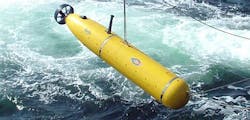Navy recommends Bluefin 21 underwater drone for next-generation Black Pearl research
WASHINGTON, 24 May 2013. U.S. Navy researchers need to develop as many as five new-generation unmanned underwater vehicles (UUVs) for research programs in anti-submarine warfare (ASW) and mine countermeasure (MCM) missions. They are finding their solution from Bluefin Robotics Corp. in Quincy, Mass.
Officials of the Naval Research Laboratory (NRL) in Washington announced their intention this week to negotiate with Bluefin on a sole-source basis to develop an underwater drone for research in long range and multi-static mine hunting and ASW programs, as well as in new distributed sensing research.
The announcement, solicitation number N00173-13-R-BC04, calls for Bluefin to develop next-generation research UUVs based on the company's Bluefin 21 UUV for the Navy's experimental Black Pearl AUV.
The mechanical, electrical, and logical interfaces are specific to the Bluefin 21, Navy researchers say. The control software between the payloads and the main vehicle computer that controls the overall mission, also is unique.
NRL scientists have designed and built significant hardware and software over several years that works effectively with the Bluefin 21 architecture, officials say, explaining that no other UUV is appropriate for this kind of research.
Although NRL officials are not releasing a request for proposals, they will consider proposals or quotes from all responsible sources until 4 June 2013.
Navy researchers want a state-of-the-art 21-inch-diameter UUV with GPS/INS/DVL navigation capability, low noise propulsion, and onboard energy sufficient to carry out missions longer than 24 hours. The vehicle will carry out missions according to a sortie plan defined by an operator employing a graphics-based PC mission planning tool.
The top-level requirements for the vehicle are a 3-to-5-nautical-mile per hour operating speed, a 400 meter depth capability, a minimum of 18 kilowatt-hour energy storage, and a real-time GPS-aided fiber optic gyro (IXSEA PHINS III), inertial navigation system (INS) integrated with Doppler velocity log instrument capable of measuring the vehicle's horizontal position, velocity, and attitude.
The position accuracy drift rate while traveling submerged on a straight line, will be 0.15 percent of distance traveled, or less. The system should have an over-the-horizon (OTH) communication capability for periodic vehicle status, monitoring, and redirection using Iridium satellite communications system while the vehicle is on the surface.
The UUV should be able to support several payload types, supplied by NRL researchers, that may include broadband low frequency sonars for MCM and ASW; environmental data sensors such as water depth, speed of sound in water along vehicle path, water temperature, and water current); and payloads for acoustic modem research (ACOMMS).
Companies interested should email proposals or quotes no later than 4 June 2013 to the Navy's Charlotte Brooks at [email protected].
More information is online at https://www.fbo.gov/spg/DON/ONR/N00173/N00173-13-R-BC04/listing.htm.

